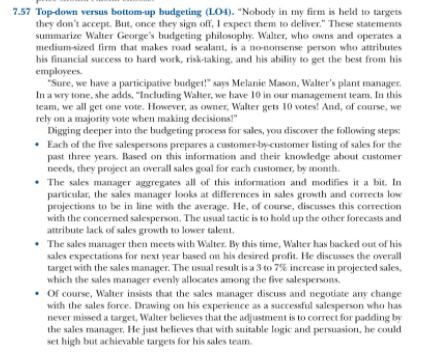

7.57 Top-down versus bottom-up budgeting (LO4). "Nobody in my firm is held to targets they don't accept. But, once they sign off, I expect them to deliver." These statements summarize Walter Georges budgeting philosophy. Walter, who owns and operates a medium-sized firm that makes road sealant, is a no-nonsense person who attributes his financial success to hard work, risk-taking, and his ability to get the best from his employees "Sure, we have a participative budget!" says Melanie Mason, Walter's plant manager. In a wry tone, she adds, "Including Walter, we have 10 in our management team. In this team, we all get one vote. However, as owner, Walter gets 10 votes! And, of course, we rely on a majority vote when making decisions!" Digging deeper into the budgeting process for sales, you discover the following steps . Each of the five salespersons prepares a customer-by-customer listing of sales for the past three years. Based on this information and their knowledge about customer needs, they project an overall sales goal for each customer, by month. The sales manager aggregates all of this information and modifies it a bit. In particular, the sales manager looks at differences in sales growth and corrects low projections to be in line with the average. He, of course, discusses this correction with the concerned salesperson. The usual tactic is to hold up the other forecasts and attribute lack of sales growth to lower talent. The sales manager then meets with Walter. By this time, Walter has backed out of his sales expectations for next year based on his desired profit. He discusses the overall target with the sales manager. The usual result is a 3 to 7% increase in projected sales, which the sales manager evenly allocates among the five salespersons. . Of course, Walter insists that the sales manager discuss and negotiate any change with the sales force. Drawing on his experience as a successful salesperson who has never missed a target, Walter believes that the adjustment is to correct for padding by the sales manager. He just believes that with suitable logic and persuasion, he could set high but achievable targets for his sales team. Required: Comment on the participative nature of the sales budgeting process at Walter's firm. What kinds of positive and negative behaviors do such processes encourage? 7.57 Top-down versus bottom-up budgeting (LO4). "Nobody in my firm is held to targets they don't accept. But, once they sign off, I expect them to deliver." These statements summarize Walter Georges budgeting philosophy. Walter, who owns and operates a medium-sized firm that makes road sealant, is a no-nonsense person who attributes his financial success to hard work, risk-taking, and his ability to get the best from his employees "Sure, we have a participative budget!" says Melanie Mason, Walter's plant manager. In a wry tone, she adds, "Including Walter, we have 10 in our management team. In this team, we all get one vote. However, as owner, Walter gets 10 votes! And, of course, we rely on a majority vote when making decisions!" Digging deeper into the budgeting process for sales, you discover the following steps . Each of the five salespersons prepares a customer-by-customer listing of sales for the past three years. Based on this information and their knowledge about customer needs, they project an overall sales goal for each customer, by month. The sales manager aggregates all of this information and modifies it a bit. In particular, the sales manager looks at differences in sales growth and corrects low projections to be in line with the average. He, of course, discusses this correction with the concerned salesperson. The usual tactic is to hold up the other forecasts and attribute lack of sales growth to lower talent. The sales manager then meets with Walter. By this time, Walter has backed out of his sales expectations for next year based on his desired profit. He discusses the overall target with the sales manager. The usual result is a 3 to 7% increase in projected sales, which the sales manager evenly allocates among the five salespersons. . Of course, Walter insists that the sales manager discuss and negotiate any change with the sales force. Drawing on his experience as a successful salesperson who has never missed a target, Walter believes that the adjustment is to correct for padding by the sales manager. He just believes that with suitable logic and persuasion, he could set high but achievable targets for his sales team. Required: Comment on the participative nature of the sales budgeting process at Walter's firm. What kinds of positive and negative behaviors do such processes encourage








